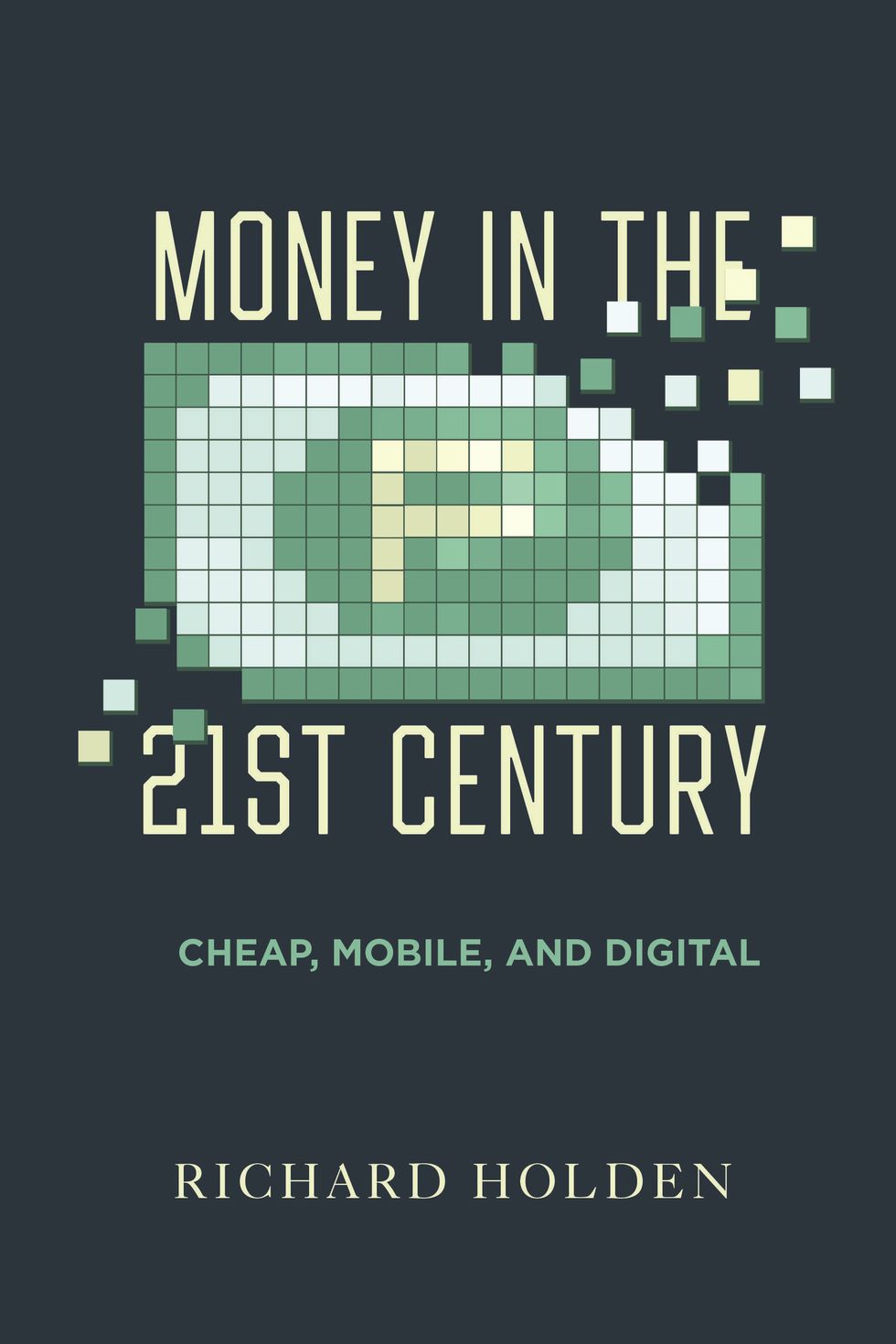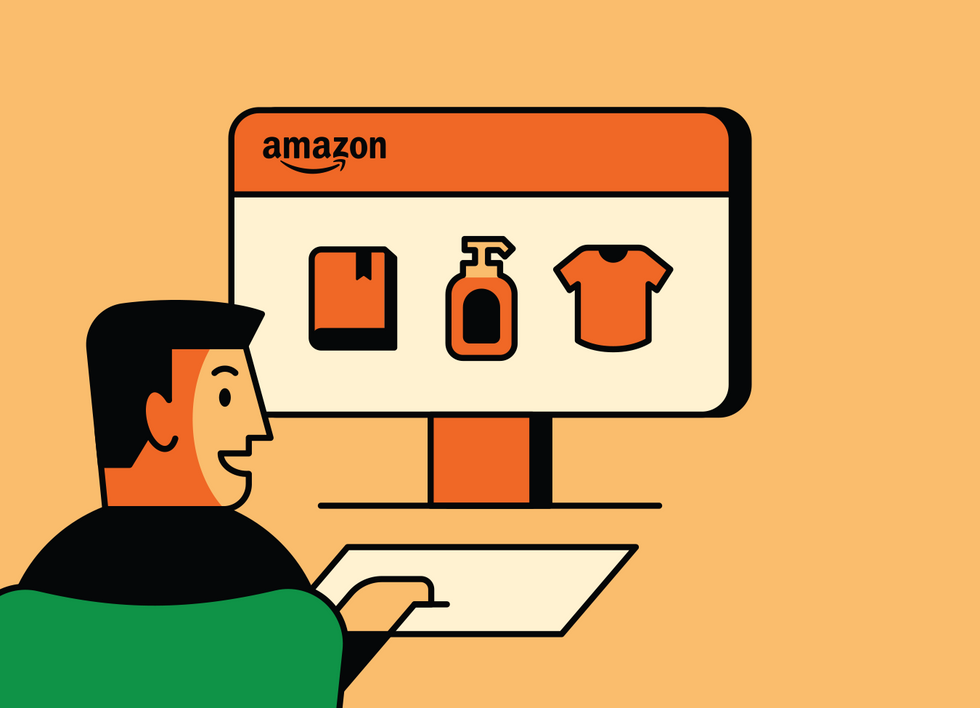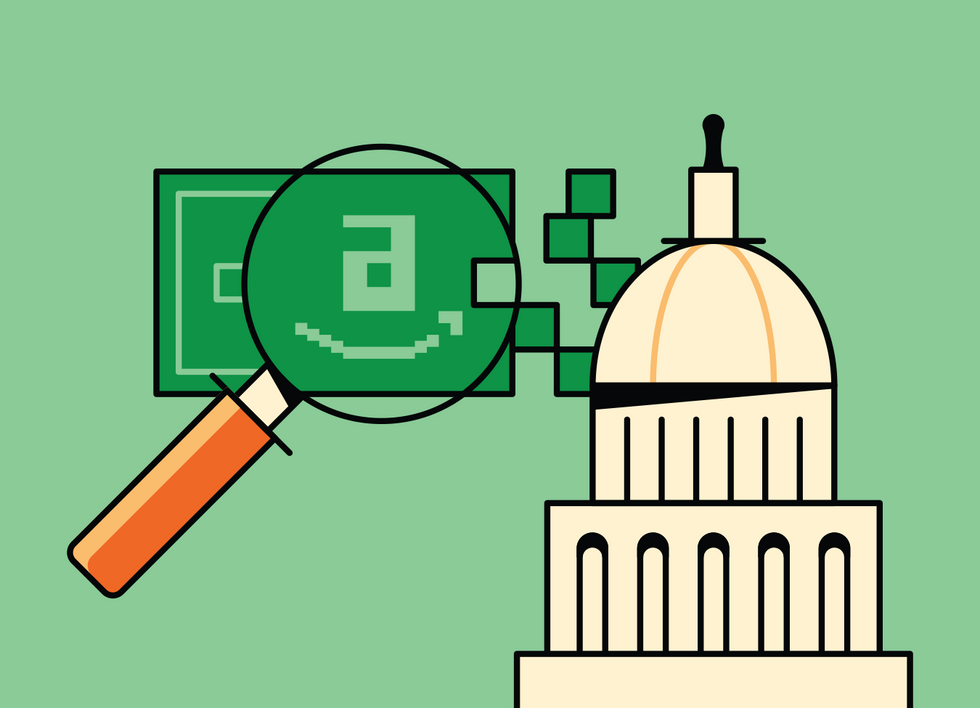Bezos Bucks? Get Ready for Corporate Digital Currency
Facebook failed, but another tech giant might soon pull it off

Buying and selling cryptocurrencies is a big business. Bitcoin, for example, processed US $3 trillion worth of transactions in 2021, more than double what American Express did. But most of those transactions were just for speculation. The fraction that involved buying actual stuff (goods and services) is so small that it’s hard to measure.
What development might enable cryptocurrencies to displace the U.S. dollar as the dominant medium for exchange in the United States? It might look a lot like what Facebook (now called Meta) proposed with its Libra stable coin (which morphed into Diem). Although Diem suffered a fatal setback in 2021 when U.S. Treasury Secretary Janet Yellen refused to support it, that doesn’t mean that a related model couldn’t succeed. Indeed, Yellen’s refusal to support Diem suggests that she saw a private digital currency as a potentially serious competitor to the U.S. dollar—and hence to the U.S. Treasury.
Here I outline the rationale for such a private digital currency and explain how one might soon take off in the United States.
Corporate Cash

This article was adapted from portions of the author’s upcoming book, Money in the Twenty-First Century: Cheap, Mobile, and Digital (University of California Press, 2024).
University of California Press
The idea of private digital currencies goes back to at least 1994, when the late Edward de Bono wrote of the “IBM dollar.” In de Bono’s vision, “large manufacturing corporations” should create their own currencies, which could be used to buy their products. He saw this scheme chiefly as a way for companies to smooth out the volatility of sales and make their business more predictable.
Facebook’s Libra proposal flopped. How might another private digital currency succeed where Libra did not?
It is important to attract a large block of customers quickly. This is sometimes referred to as “getting the flywheel going”—that is, operating on a large enough scale for the benefits to consumers from network effects to kick in. Facebook’s user base would perhaps have provided such a block of customers, but there is some psychological distance between social media and money.
That gap could be much smaller for other potential backers of a private digital currency. An important early paper (2015) by Joshua Gans and Hanna Halaburda on private digital currencies pointed out that “any currency can be viewed as a platform”—and it is the attractiveness of the platform on which its adoption depends.
Bezos Bucks

Consider Amazon, with more than 200 million unique visitors to its site every month. It has annualized sales revenue of about $500 billion a year. A staggering 167 million Americans have an Amazon Prime membership—a service that offers discounted or free shipping in exchange for a $139 annual fee, making Amazon their effective default shopping option for a vast range of merchandise. This large sticky customer base makes it plausible that Amazon could launch its own digital currency. Borrowing a few pages from the Libra playbook, it might look like this:
The currency would have four pillars. The first involves the Amazon platform. Amazon would announce that from now on, while users could continue to pay by credit card for purchases, they could also use a digital currency called amazons. (I like Bezos bucks or BBs, but that might be a bridge too far, even for Jeff Bezos.) Customers could convert U.S. dollars into amazons—and, at least for the time being, they could convert them back, on demand, at a 1:1 exchange rate, perhaps for a small fee.
Using amazons for purchases would give users a discount off the regular purchase price, maybe 2 percent. That would give folks an incentive to use amazons. Indeed, Amazon already offers a virtual currency called Amazon coins, which can be used on the Amazon Appstore to buy certain apps and games and make in-app purchases. So amazons would be a natural extension of that.
As a platform that matches buyers and sellers, Amazon has considerable market power and leverage. In principle, Amazon could mandate that sellers had to accept amazons instead of dollars for sales in the Amazon marketplace. Such an arrangement would be unlikely to work in the short term, though, because amazons would be no use to retailers, who need to pay their suppliers in dollars—at least not at the start.
But if amazons were in sufficiently widespread use, this would be no problem. The challenge for Amazon would be to drive adoption of its currency without penalizing sellers on its platform. The smart approach would be to pay sellers some portion of their sale price in amazons—maybe 10 percent initially—and the rest in dollars. Each seller would have a digital wallet into which amazons would be paid. The amazons could be converted frictionlessly into dollars.
This approach would create a subtle but useful default for Amazon. Although it would not be hard for sellers to convert their amazons to dollars, the presence of amazons in their digital wallet, ready to be spent elsewhere on the Amazon platform, would offer an incentive to use them.
Paying interest on funds saved in the wallet would motivate sellers to park their money in an Amazon digital wallet rather than transferring it to their bank and earning close to zero interest there. The introduction of these features would provide a natural way for Amazon to offer other financial services for small businesses.
A Second Pillar

Pillar 2 involves Amazon Web Services (AWS), the world’s largest cloud-computing company. It started out as a means of running Amazon’s own platform and has since grown into a company that offers similar services to other companies and even university researchers.
Netflix is AWS’s largest customer. Not far behind, in terms of monthly spending, are Twitch and LinkedIn. Other major companies that run a significant part of their business on AWS include Baidu, BBC, ESPN, Facebook/Meta (for third-party collaborations with existing AWS users), and Turner Broadcasting.Requiring these very significant customers to hold amazons—without any sweetener—would be similar to saying that those companies had to pay in advance for AWS services rather than being billed on commercial terms. It would be like a straight transfer of working capital between AWS and its customers—for the benefit of AWS. Such an approach, incurring extra costs to the customers, would be unlikely to succeed. But Amazon/AWS could offer a form of partnership with some or all of these big companies. This would increase the likelihood of a private digital currency taking hold.
But keep in mind what happened a few years ago, when Facebook’s Libra Association lost key payments companies, including Visa. These companies had two main concerns.
The first was whether the Libra Association would fully comply with regulatory requirements. During a House Financial Services Committee hearing in October 2019, Representative Maxine Waters (D-Calif.) asked David Marcus, the head of the project at Facebook, whether the company would wait for Congress to consider appropriate regulation. Marcus replied, “I committed to waiting for us to have all the appropriate regulatory approvals and have addressed all concerns before moving forward.” Waters said, “That’s not a commitment.” Marcus seemed to be suggesting that Facebook would comply with existing regulations, whereas lawmakers on the committee had made clear throughout the hearing that an innovation of this magnitude could require significant new regulations.
An important early paper on private digital currencies pointed out that “any currency can be viewed as a platform”—and it is the attractiveness of the platform on which its adoption depends.
The second concern was Facebook’s reputation and past behavior, including its involvement in Cambridge Analytica, a British company that, during the 2010s, collected a trove of personal data from Facebook users without their consent and used it for political-advertising purposes.
These concerns were most crisply expressed by Representative Alexandria Ocasio Cortez (D-N.Y.), who said to Facebook founder Mark Zuckerberg: “I think you of all people can appreciate using a person’s past behavior in decisions about future behavior. In order for us to make decisions about Libra, I think we need to kind of dig into your past behavior, Facebook’s past behavior, with respect to our democracy. Ah, Mr. Zuckerberg, what year and month did you personally first become aware of Cambridge Analytica?”
By the time of this exchange, Visa had already withdrawn from the Libra Association, issuing the following statement: “[Visa] will continue to evaluate and our ultimate decision will be determined by a number of factors, including the Association’s ability to fully satisfy all requisite regulatory expectations. Visa’s continued interest in Libra stems from our belief that well-regulated blockchain-based networks could extend the value of secure digital payments to a greater number of people and places, particularly in emerging and developing markets.”
This exchange points to the vital importance of reputation in inducing corporations to use a private digital currency. A sticky customer base may be sufficient to attract consumers, but major companies like Visa, Netflix, or ESPN need to be confident that participation will enhance, not diminish, their reputation.
Facebook simply had too much baggage, especially after the 2016 election, to be a credible backer of a digital currency. True to Zuckerberg’s famous aphorism—“ Move fast and break things”—the company had moved fast in using the personal data of its users for profit and political advertising.
That said, a private digital currency could offer significant advantages to companies like Netflix and ESPN. Companies like
AT&T and Microsoft already allow their customers to pay in crypto through payments processors like BitPay. It doesn’t really matter why they have opted to do so: because it sounds cool, because their customers have a philosophical
commitment to crypto, or because of privacy concerns. All that matters is that customers seem to want the option. A more stable digital currency would be more appealing to large companies. It might even allow them to expand into other product lines: For example, ESPN might offer sports betting, something it has already
shown an interest in, though such undertakings would have regulatory complications.
Even if some of these companies balked at accepting the leadership of Amazon, a competitor, all of them would understand that the power to control money in the United States—and perhaps elsewhere—would create an extraordinary pool of business income streams. There would be more than enough of those to go around, even if Amazon got the largest share.
And a Third Pillar

Pillar 3 is regulatory. Amazon would acknowledge that by issuing amazons it would effectively be acting as a money-market mutual fund. So the company would readily agree to have its currency operation regulated by the U.S. Securities and Exchange Commission as a money-market fund (MMF).
MMFs are subject to what’s known as Rule 2a-7 of the Investment Company Act of 1940. That rule specifies a number of conditions about how an MMF’s portfolio can be invested, including the credit quality of assets in which an MMF can invest, how diversified the portfolio must be, how liquid it must be, and the maturity structure of the assets held. Amazon could agree to meet or exceed all these conditions and commit to making its digital currency reserve the squeakiest of squeaky-clean money-market funds.
If Amazon started to expand into other financial services, such as offering credit products to sellers on its platform, then there would be other regulations with which it would need to comply. But the main game for Amazon would be creating a dominant private digital currency, not trying to make money or skirt regulations related to banking operations. So it could, in this domain, act completely in good faith while pursuing the objective of getting the network-externality flywheel spinning to expand the use of its digital currency.
Regulatory compliance also would allow amazons to have the stable-coin features that were at the heart of the Libra model. Instead of the Libra Reserve, there would be the Amazon Reserve. Keeping its entire reserve in U.S. government securities would satisfy regulatory requirements and also give amazon holders confidence that they could exchange them for U.S. dollars (or other currencies, as Amazon is a global business) on demand.
Amazon would essentially run a money-market fund in each of the currencies with which it offered convertibility. This would be an advantage for international consumers who wanted to avoid exchange-rate risk. Moreover, it would arguably give holders of amazons greater faith that there would not be a modern-day bank run on amazons, because convertibility into local currencies would reduce the risk of exchange-rate hedging by customers.
The Final Pillar

Pillar 4 is financial inclusion. With its efforts on Libra, Facebook drew a compelling picture of the plight of those excluded from banking—not only in sub-Saharan Africa but also in South Central Los Angeles and the South Side of Chicago. Many people in these communities have no bank account or else pay extremely high fees for access to ATMs and other basic banking services. Lacking other options, they may pay exorbitant interest rates on payday loans.
Part of the pitch for a private digital currency could be offering people in these communities access to cheap, secure financial services. While doing so might not be profitable for existing banks and financial-services companies, a company like Amazon could easily absorb the cost as a kind of loss leader.
Elements of this idea bear a relationship to an initially underappreciated benefit of blockchain technology—the financial innovation known as
initial coin offerings. ICOs are a novel financial use of so-called tokens, or coins, issued on a blockchain ledger to raise money for blockchain investments. Tokenization permits the creation of a range of financial instruments, some new and some simply better, that have great potential in financial markets.
To see how this works, let’s start with Filecoin, which raised $257 million in 2017 in its ICO. The purpose of the underlying enterprise was to set up a data-storage market. Both buyers and sellers would have to use FIL tokens for transactions. Filecoin promised to issue a maximum of 200 million FIL tokens. So, in principle, the total value of all FIL tokens would be equal to the revenue generated in that part of the disk-storage market. The value of a single token is this revenue divided by the number of tokens.
The owner of a FIL token is essentially buying a security connected to (and making a bet on) revenue in the data-storage market. The holder of such a security can resell it to people who want to buy storage on the network. In the ICO, 10 percent of the tokens were sold to investors, so the total valuation of Filecoin’s future revenues was $2.57 billion.
Amazon is not the only company that might be able to create a private digital currency that largely supplants the U.S. dollar. Google also has a huge base of both consumer and business users. Apple is another obvious example.
That is not to say that a private digital currency created by one of these tech giants would create social value. Indeed, it would create complex problems involving tax avoidance, monetary policy, illicit activity, and more.
The challenge confronting the United States government is that maintaining the status quo looks difficult, and it might need to make a preemptive move to a central-bank digital currency to prevent the establishment of a private digital currency that competes with the dollar. But one way or the other, you’ll likely be seeing such a currency arriving soon.
This article appears in the December 2023 print issue as “Get Ready for Corporate Digital Currencies.”


